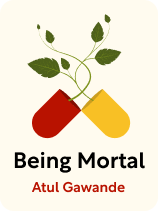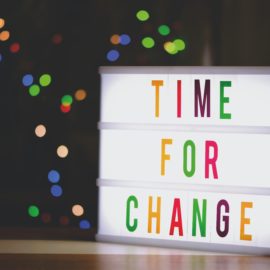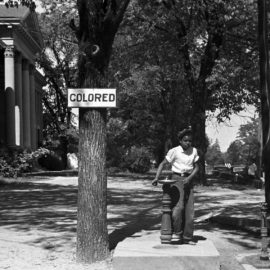

This article is an excerpt from the Shortform book guide to "Being Mortal" by Atul Gawande. Shortform has the world's best summaries and analyses of books you should be reading.
Like this article? Sign up for a free trial here.
What is Atul Gawande’s Being Mortal about? What is the key message to take away from the book?
In his book Being Mortal, surgeon Atul Gawande considers our experience of aging and dying in the 21st century. In his view, the modern approach to these stages of life undermines our ability to live well up to the end—to do better, we need to accept death as a natural part of the human experience and prioritize the well-being of the dying.
Below is a brief overview of Being Mortal: Medicine and What Matters in the End by Atul Gawande.
Being Mortal: Medicine and What Matters in the End
In his book Being Mortal, surgeon Atul Gawande looks at the experience of aging and dying in the 21st century. Critics widely praised Being Mortal and considered it one of the best books of the year when it was published in 2014. It’s since been adapted into a TV documentary and a feature film.
The Way We Age and Die Today
People today live longer and better than ever before thanks to modern medical technology and other advances, but Gawande argues that the process of aging and dying has become worse. In this section, we’ll look at four problems he identifies in our modern approach to the end of life: We rarely live with aging parents and grandparents, we rely on medical institutions, we don’t manage physical frailty well, and we don’t prepare for death.
We Don’t Live With the Elderly in Multigenerational Households
One defining feature of the way we experience aging today concerns the typical household, contends Gawande: We no longer live in a multigenerational setting. Research shows that the percentage of elderly people living with their children dropped from 60% in the early 20th century to less than 15% in 1960.
It was once typical for the elderly to live with their children and grandchildren under one roof. These elders usually enjoyed a place of honor in the home and community, maintained personal autonomy, were diligently cared for, retained a sense of belonging and purpose through their final moments, and died among loved ones. Gawande concedes that this arrangement wasn’t always easy, but he suggests that in all these ways, it met many of the core needs of the elderly that we neglect today. Moreover, it made younger generations more aware of mortality by exposing them to the realities of aging and dying.
Despite all these benefits, Gawande offers two reasons why we don’t live together anymore:
First, we don’t honor the elderly. This is largely because people live longer than ever before—reaching old age isn’t that special now. Life expectancy has gradually risen in the developed world since the early 20th century because of advances in medical technology, safer workplaces, and more stable food sources. When life expectancy was short, the rare person who survived into old age would have been honored.
Second, younger and older generations don’t depend on one another for economic security. One reason for this is that job opportunities are more varied than in the past: A child is no longer obliged to take over the family trade. Also, economic safety nets such as Social Security and Medicare in the US provide financial support for the elderly. Because of this, it’s easy for individual family members to forge independent lives for themselves, including living separately.
According to Gawande, we’ve failed to make up for the lost benefits of living with aging parents and grandparents: The elderly still need physical care and a sense of purpose, and we need to see aging and dying as a natural part of life.
We Live With Frailty Longer but We Don’t Manage It Well
A second feature of our modern approach to mortality involves the way we handle the aging body. Because more of us reach old age than ever before, more of us live longer with its frailty. Gawande notes that while modern advances help us avoid infection, disease, and accidents better than ever, they haven’t stopped the natural aging process. Worn out from long use, our bones and teeth lose density, our skin thins, we lose muscle mass, and our internal organs begin to malfunction. Accustomed to modern medicine’s ability to restore our health, we haven’t prepared ourselves to live with these inevitable infirmities.
As Gawande sees it, we usually deal with the symptoms of aging as if they can be reversed, but they can’t. He argues that we need to accept the deterioration of the body as natural and focus on supporting the elderly as they face limitations, not on curing them of aging. Unfortunately, non-specialist physicians—accustomed to curing patients through medical interventions—are usually the ones caring for the elderly.
According to Gawande, these physicians often fail to address the everyday physical and emotional challenges of aging. They may focus on blood pressure fluctuations while overlooking poor hygiene caused by reduced flexibility or weight loss caused by loneliness. Gawande suggests that basic needs, such as the ability to get in the shower or enjoy a meal with loved ones, are more critical to an old person’s daily well-being than are the narrow medical issues most doctors focus on.
Geriatricians Are Needed but Uncommon
Geriatricians are medical specialists trained to support the elderly in this way, explains Gawande. These physicians are skilled at identifying the problems caused by aging—for instance, the difficulties the elderly may have with hygiene, eating well, maintaining social contact, and controlling aches and pains. They can provide resources to make bathing easier or ensure the elderly are eating regularly. By closely watching and addressing these everyday problems, geriatricians help the elderly maintain their quality of life as their bodies age.
Unfortunately, the elderly often don’t have access to geriatricians: Gawande laments the fact that the number of geriatricians has fallen despite the fact that the elderly population is growing.
We Relegate the Aging and Dying to Medical Institutions
A third aspect of our modern experience of the end of life deals with our reliance on medical institutions for end-of-life care. In our era of advanced healthcare, we typically relegate the aging and dying to hospitals and nursing homes if they need regular care.
Gawande argues that these institutions fail to provide such patients with adequate autonomy and a sense of belonging. Nursing homes and hospitals are designed for narrow medical aims that are often at odds with the things that add value to life, such as personal freedom and feeling connected to others. In these conditions, residents feel bored, lonely, and depressed.
There have been alternative models of care that try to do a better job, but they’re not commonly practiced, writes Gawande. For example, the original assisted living model of care was designed in the 1980s to promote personal freedom. Residents could live in a comfortable space and direct their own lives—they could choose when they wanted to sleep, what they wanted to eat, and so on. Early studies of these facilities found that residents had improved cognitive and physical health, higher levels of satisfaction, and less depression than those who stayed in nursing homes.
Despite its success, this alternative assisted living model of care is rarely practiced today, though many institutions use the name. According to Keren Brown Wilson (the founder of the model), its failure exposes the ongoing difficulties we face in supporting the deeper needs of the elderly: Institutional priorities—regulations, profits, performance goals, and so on—aren’t aligned with the priorities of the residents.
For example, metrics like blood pressure stats and injury reports often become the gauge of an institution’s success. Since independent people (the elderly included) often minimize their health and safety in favor of doing things they like, such metrics discourage organizations from giving residents autonomy. For instance, an elderly person may not be allowed to go on a nature walk due to the risk of falling. Despite their good intentions, institutions often sacrifice personal freedom and a sense of meaning in support of health, safety, and the bottom line.
We Don’t Prepare for the End of Life
One final feature of aging and dying in our modern era is our reluctance to prepare for death. Gawande observes that we rarely contemplate the final days of life—if we’re confronted with an unexpected terminal diagnosis, doctors, patients, and family members often default to a frenetic search for a cure. In this way, we become consumed by anxiety and denial, and we sacrifice a sense of meaning and closure as death approaches.
Gawande asserts that because we lived with ever-present reminders of death for most of human history, we were once accustomed to facing it. Life was full of hazards—incurable diseases, rampant infections, dangerous tasks, and so on. On top of that, we were more accustomed to seeing people, such as elderly family members, die. Expecting your time to come at any moment, it was common to prepare in advance. Getting ill or contracting an infection would have made you realize your time was limited, and you would have accepted that reality: Survival was an unrealistic expectation.
Now, however, advances in medical technology have prolonged the process of dying, writes Gawande. Patients can be kept alive long after their minds are inactive and their bodies immobile. With endless treatment options available, we’ve neglected to accept our mortality—as he sees it, we must relearn how to die.
How We Can Approach Aging and Dying Better
Gawande believes that our current approach to aging and dying harms our well-being. Throughout Being Mortal, he suggests some specific ways we can do better. In this section, we’ll consider four of those ideas.
We Need to Reorient Our Priorities From the Future to the Present
One way we can improve our experience of aging and dying is by reorienting our end-of-life care toward present-oriented priorities.
Referring to the work of psychologist Laura Carstensen, Gawande observes that our priorities change depending on how much time we believe we have left to live. People close to death have a present-oriented outlook: They value close relationships, treasured memories, and simple pleasures. However, the people caring for them tend to have a future-oriented outlook. They value ambitious life goals, personal independence, meeting new people, and having new experiences—and they often assume their patients share their outlook.
Our modern approach to dying is dominated by this future-oriented perspective and so neglects the core values of the dying, argues Gawande. A feeling of togetherness, for instance, is central to a present-oriented perspective: The dying are rarely interested in making new friends and acquaintances because they want to feel connected with their deepest, oldest relationships. Hospitals and nursing homes, however, are characterized by a feeling of isolation among strangers and new acquaintances.
Likewise, doctors who overlook the simple daily needs of their elderly patients fail to recognize that, for the dying, living well in the present is more important than hoping for a better future. Often, Gawande finds that doctors work to extend the lives of their patients, inadvertently depriving those lives of meaning and purpose in the present.
We Need to Talk About Aging and Dying
According to Gawande, another way we can improve our experience of our mortality is by talking about aging and dying more openly. We tend to avoid these conversations, but that leaves us ill-prepared to deal with the challenges aging and dying present.
These challenges elicit powerful emotions we must acknowledge to reduce some of the fear and uncertainty that surrounds death. For instance, the dying often fear the process of decline—the pain, memory loss, or the suffering their loved ones endure. These fears are often mixed with powerful hopes, as well—hope for a cure, for comfort, for the ability to stay lucid.
According to Gawande, such concerns should be acknowledged and discussed openly to navigate the final days of life. These are difficult conversations, and many doctors mishandle them. For instance, some dominate the conversation, focusing on how to fix the problem and plan a course of treatment. Others are more reserved, preferring to let the patient or family make all the decisions with little or no guidance.
However, a few well-practiced physicians use an approach Gawande believes is best: the interpretive approach. With this approach, doctors help patients speak about their fears and hopes and figure out exactly what they want for their end-of-life care. They give them information about their prognosis, treatment options, and potential risks and rewards, but they also help them understand the implications of that information as it relates to the patient’s deepest concerns.
Often, by determining what a patient hopes to be able to do, whether it’s making it to a child’s wedding or simply enjoying food, doctors can advise patients about the best strategy to help them achieve their goals. Similarly, by understanding what a patient fears most—the indignity of being unable to control bodily functions, for instance—doctors can help steer patients toward the best options. In this way, by working with the patient, doctors can tailor an approach to their end-of-life care.
Family members can model their own conversations about death on this approach. The most important components are acknowledging death, being clear about hopes and fears, and deciding what to prioritize as time runs short, writes Gawande.
We Need to Help the Dying Retain Their Autonomy
A third way we can improve our approach to mortality has to do with autonomy. Gawande believes that helping the dying preserve their autonomy is one of the most important aspects of end-of-life care. He distinguishes between negative and positive autonomy.
Negative autonomy is the absence of constraints. This is the autonomy we look for when we simply want our body to be fully functional and healthy. To Gawande, this autonomy is no longer critical for the aging and terminally ill—on the contrary, as our bodies weaken, it’s vital to acknowledge our limitations and dependence.
Positive autonomy, by contrast, is the freedom to direct your life. According to Gawande, this freedom is crucial for those facing death, as it allows them to live according to their values and retain meaning in spite of severe limitations.
One way to help the dying retain this kind of autonomy is to establish it as the priority in end-of-life care. Gawande argues that by keeping this in mind, you’re better able to judge which actions to take. Caretakers should work with the dying to help them maintain their ability to direct their lives toward the things that give them purpose and meaning.
This can manifest in different ways. Some elderly people may choose to care for a pet, for instance. Others may simply enjoy listening to music or being outside. Elderly individuals will choose to spend their time in different ways if they can make that choice.
In the case of the terminally ill, facilitating their autonomy may involve letting them choose to forgo treatments that could extend their lives but that may cause pain or isolation. Or it may involve ensuring they have medication to manage pain. The goal is to support their ability to choose the way they spend their final days.
We Need to Be Judicious in Our End-of-Life Healthcare
According to Gawande, a final way we can improve our approach to dying is to be judicious in our end-of-life healthcare. This involves being decisive about what we want and resisting the urge to address every ailment the dying face.
Gawande insists we should decide exactly what we want for our last days. Do we want to undergo every possible life-saving treatment? Or are we willing to forego treatment so we can stay clearheaded and have more time with our loved ones? Should doctors try to resuscitate us? Or will we let our bodies naturally give out? We must consider these difficult questions if we hope to give ourselves and our loved ones peace and closure in our final moments.
If we don’t decide how we want to live our final days, we’ll likely get caught up in the inertia of our modern, medicalized approach to dying, which will undermine our ability to find peace. The dying are often barraged with endless treatments and relegated to the isolation of a hospital ward, unable to experience closure as they should. Gawande argues that the dying should have the chance to wrap up their affairs, share their deepest thoughts, encourage their loved ones, and establish their legacies. Being deprived of these opportunities is devastating for those facing death, but medical institutions often do just that.
Hospice as a Model for Judicious End-of-Life Care
According to Gawande, hospice contrasts with this approach and is a model of judicious end-of-life healthcare. It’s designed to support the well-being of the dying and their loved ones by helping them determine and focus on their urgent end-of-life priorities. It reduces or eliminates invasive treatments in favor of comfort and peace. Hospice caretakers reduce distractions for their patients so they can find closure: They treat the process of dying as a natural experience patients can meet with clarity and calm.
Gawande writes that this form of care has been shown to extend the lives of patients when compared with traditional interventionist medical care, but it’s not practiced as widely as it should be. More should be done, he suggests, to make hospice care commonplace.

———End of Preview———
Like what you just read? Read the rest of the world's best book summary and analysis of Atul Gawande's "Being Mortal" at Shortform.
Here's what you'll find in our full Being Mortal summary:
- What it's like to age and die in the 21st century
- Why we need to be better at accepting death
- How to improve the well-being of the aging and dying







Loved this Ssinusoid article. I read Atul Gawande’s earlier book complications, and liked it very much. I am going to check this latest book out of the library posthaste! Thank you dearest sinusoid, and Atul GawandeL